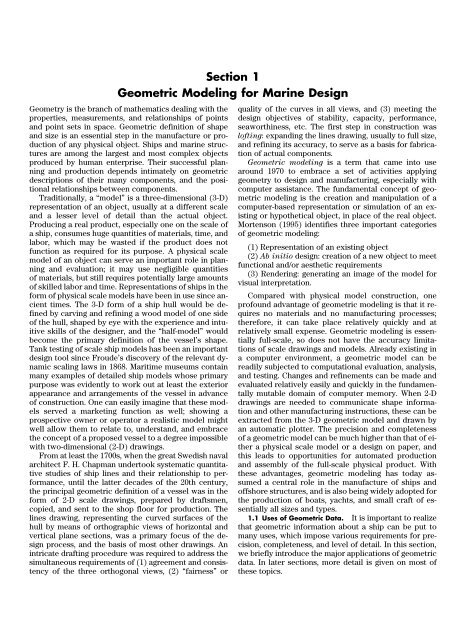The Geometry of Ships
You also want an ePaper? Increase the reach of your titles
YUMPU automatically turns print PDFs into web optimized ePapers that Google loves.
Section 1<br />
Geometric Modeling for Marine Design<br />
<strong>Geometry</strong> is the branch <strong>of</strong> mathematics dealing with the<br />
properties, measurements, and relationships <strong>of</strong> points<br />
and point sets in space. Geometric definition <strong>of</strong> shape<br />
and size is an essential step in the manufacture or production<br />
<strong>of</strong> any physical object. <strong>Ships</strong> and marine structures<br />
are among the largest and most complex objects<br />
produced by human enterprise. <strong>The</strong>ir successful planning<br />
and production depends intimately on geometric<br />
descriptions <strong>of</strong> their many components, and the positional<br />
relationships between components.<br />
Traditionally, a “model” is a three-dimensional (3-D)<br />
representation <strong>of</strong> an object, usually at a different scale<br />
and a lesser level <strong>of</strong> detail than the actual object.<br />
Producing a real product, especially one on the scale <strong>of</strong><br />
a ship, consumes huge quantities <strong>of</strong> materials, time, and<br />
labor, which may be wasted if the product does not<br />
function as required for its purpose. A physical scale<br />
model <strong>of</strong> an object can serve an important role in planning<br />
and evaluation; it may use negligible quantities<br />
<strong>of</strong> materials, but still requires potentially large amounts<br />
<strong>of</strong> skilled labor and time. Representations <strong>of</strong> ships in the<br />
form <strong>of</strong> physical scale models have been in use since ancient<br />
times. <strong>The</strong> 3-D form <strong>of</strong> a ship hull would be defined<br />
by carving and refining a wood model <strong>of</strong> one side<br />
<strong>of</strong> the hull, shaped by eye with the experience and intuitive<br />
skills <strong>of</strong> the designer, and the “half-model” would<br />
become the primary definition <strong>of</strong> the vessel’s shape.<br />
Tank testing <strong>of</strong> scale ship models has been an important<br />
design tool since Froude’s discovery <strong>of</strong> the relevant dynamic<br />
scaling laws in 1868. Maritime museums contain<br />
many examples <strong>of</strong> detailed ship models whose primary<br />
purpose was evidently to work out at least the exterior<br />
appearance and arrangements <strong>of</strong> the vessel in advance<br />
<strong>of</strong> construction. One can easily imagine that these models<br />
served a marketing function as well; showing a<br />
prospective owner or operator a realistic model might<br />
well allow them to relate to, understand, and embrace<br />
the concept <strong>of</strong> a proposed vessel to a degree impossible<br />
with two-dimensional (2-D) drawings.<br />
From at least the 1700s, when the great Swedish naval<br />
architect F. H. Chapman undertook systematic quantitative<br />
studies <strong>of</strong> ship lines and their relationship to performance,<br />
until the latter decades <strong>of</strong> the 20th century,<br />
the principal geometric definition <strong>of</strong> a vessel was in the<br />
form <strong>of</strong> 2-D scale drawings, prepared by draftsmen,<br />
copied, and sent to the shop floor for production. <strong>The</strong><br />
lines drawing, representing the curved surfaces <strong>of</strong> the<br />
hull by means <strong>of</strong> orthographic views <strong>of</strong> horizontal and<br />
vertical plane sections, was a primary focus <strong>of</strong> the design<br />
process, and the basis <strong>of</strong> most other drawings. An<br />
intricate drafting procedure was required to address the<br />
simultaneous requirements <strong>of</strong> (1) agreement and consistency<br />
<strong>of</strong> the three orthogonal views, (2) “fairness” or<br />
quality <strong>of</strong> the curves in all views, and (3) meeting the<br />
design objectives <strong>of</strong> stability, capacity, performance,<br />
seaworthiness, etc. <strong>The</strong> first step in construction was<br />
l<strong>of</strong>ting: expanding the lines drawing, usually to full size,<br />
and refining its accuracy, to serve as a basis for fabrication<br />
<strong>of</strong> actual components.<br />
Geometric modeling is a term that came into use<br />
around 1970 to embrace a set <strong>of</strong> activities applying<br />
geometry to design and manufacturing, especially with<br />
computer assistance. <strong>The</strong> fundamental concept <strong>of</strong> geometric<br />
modeling is the creation and manipulation <strong>of</strong> a<br />
computer-based representation or simulation <strong>of</strong> an existing<br />
or hypothetical object, in place <strong>of</strong> the real object.<br />
Mortenson (1995) identifies three important categories<br />
<strong>of</strong> geometric modeling:<br />
(1) Representation <strong>of</strong> an existing object<br />
(2) Ab initio design: creation <strong>of</strong> a new object to meet<br />
functional and/or aesthetic requirements<br />
(3) Rendering: generating an image <strong>of</strong> the model for<br />
visual interpretation.<br />
Compared with physical model construction, one<br />
pr<strong>of</strong>ound advantage <strong>of</strong> geometric modeling is that it requires<br />
no materials and no manufacturing processes;<br />
therefore, it can take place relatively quickly and at<br />
relatively small expense. Geometric modeling is essentially<br />
full-scale, so does not have the accuracy limitations<br />
<strong>of</strong> scale drawings and models. Already existing in<br />
a computer environment, a geometric model can be<br />
readily subjected to computational evaluation, analysis,<br />
and testing. Changes and refinements can be made and<br />
evaluated relatively easily and quickly in the fundamentally<br />
mutable domain <strong>of</strong> computer memory. When 2-D<br />
drawings are needed to communicate shape information<br />
and other manufacturing instructions, these can be<br />
extracted from the 3-D geometric model and drawn by<br />
an automatic plotter. <strong>The</strong> precision and completeness<br />
<strong>of</strong> a geometric model can be much higher than that <strong>of</strong> either<br />
a physical scale model or a design on paper, and<br />
this leads to opportunities for automated production<br />
and assembly <strong>of</strong> the full-scale physical product. With<br />
these advantages, geometric modeling has today assumed<br />
a central role in the manufacture <strong>of</strong> ships and<br />
<strong>of</strong>fshore structures, and is also being widely adopted for<br />
the production <strong>of</strong> boats, yachts, and small craft <strong>of</strong> essentially<br />
all sizes and types.<br />
1.1 Uses <strong>of</strong> Geometric Data. It is important to realize<br />
that geometric information about a ship can be put to<br />
many uses, which impose various requirements for precision,<br />
completeness, and level <strong>of</strong> detail. In this section,<br />
we briefly introduce the major applications <strong>of</strong> geometric<br />
data. In later sections, more detail is given on most <strong>of</strong><br />
these topics.



